2013 JEEP GRAND CHEROKEE brake light
[x] Cancel search: brake lightPage 479 of 661
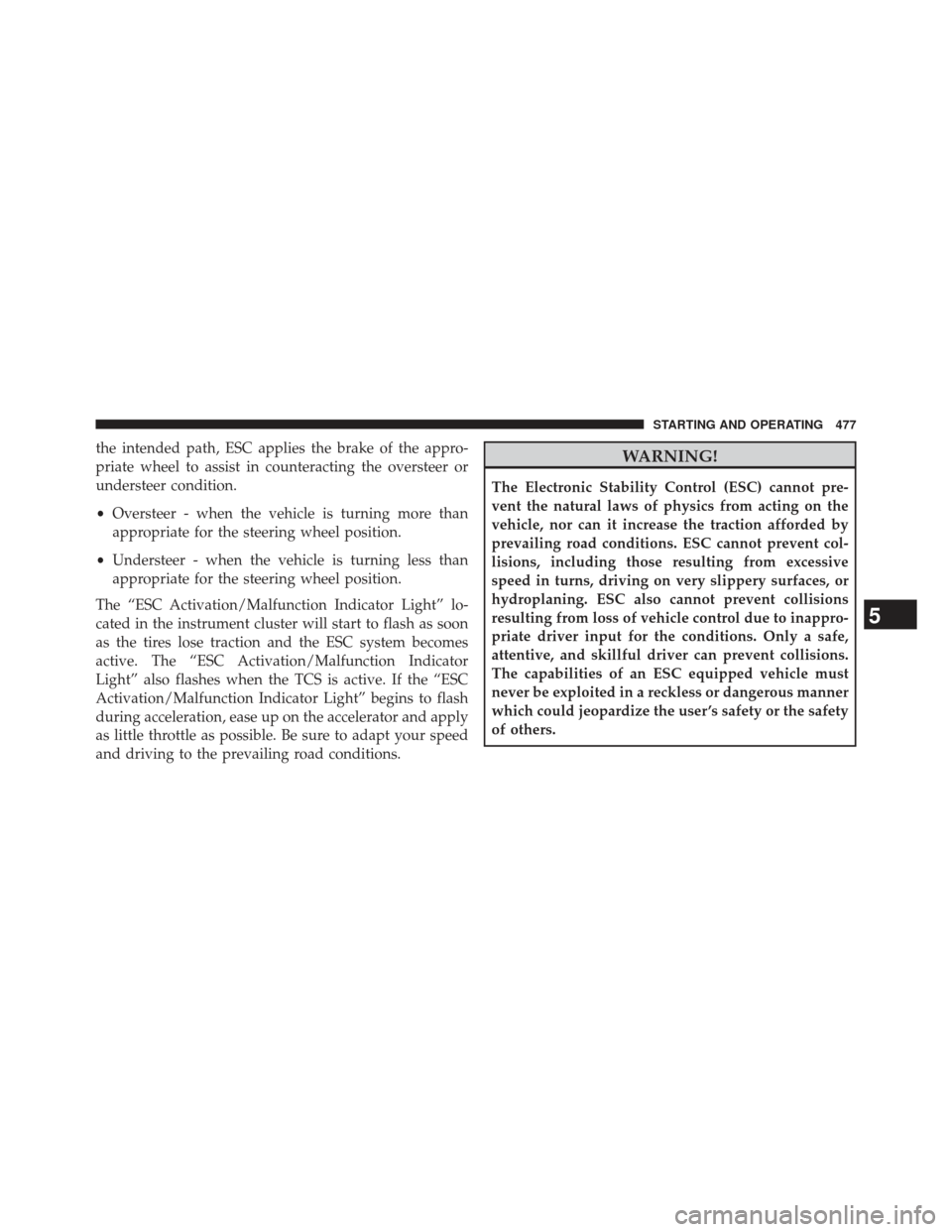
the intended path, ESC applies the brake of the appro-
priate wheel to assist in counteracting the oversteer or
understeer condition.
•Oversteer - when the vehicle is turning more than
appropriate for the steering wheel position.
• Understeer - when the vehicle is turning less than
appropriate for the steering wheel position.
The “ESC Activation/Malfunction Indicator Light” lo-
cated in the instrument cluster will start to flash as soon
as the tires lose traction and the ESC system becomes
active. The “ESC Activation/Malfunction Indicator
Light” also flashes when the TCS is active. If the “ESC
Activation/Malfunction Indicator Light” begins to flash
during acceleration, ease up on the accelerator and apply
as little throttle as possible. Be sure to adapt your speed
and driving to the prevailing road conditions.WARNING!
The Electronic Stability Control (ESC) cannot pre-
vent the natural laws of physics from acting on the
vehicle, nor can it increase the traction afforded by
prevailing road conditions. ESC cannot prevent col-
lisions, including those resulting from excessive
speed in turns, driving on very slippery surfaces, or
hydroplaning. ESC also cannot prevent collisions
resulting from loss of vehicle control due to inappro-
priate driver input for the conditions. Only a safe,
attentive, and skillful driver can prevent collisions.
The capabilities of an ESC equipped vehicle must
never be exploited in a reckless or dangerous manner
which could jeopardize the user ’s safety or the safety
of others.
5
STARTING AND OPERATING 477
Page 483 of 661
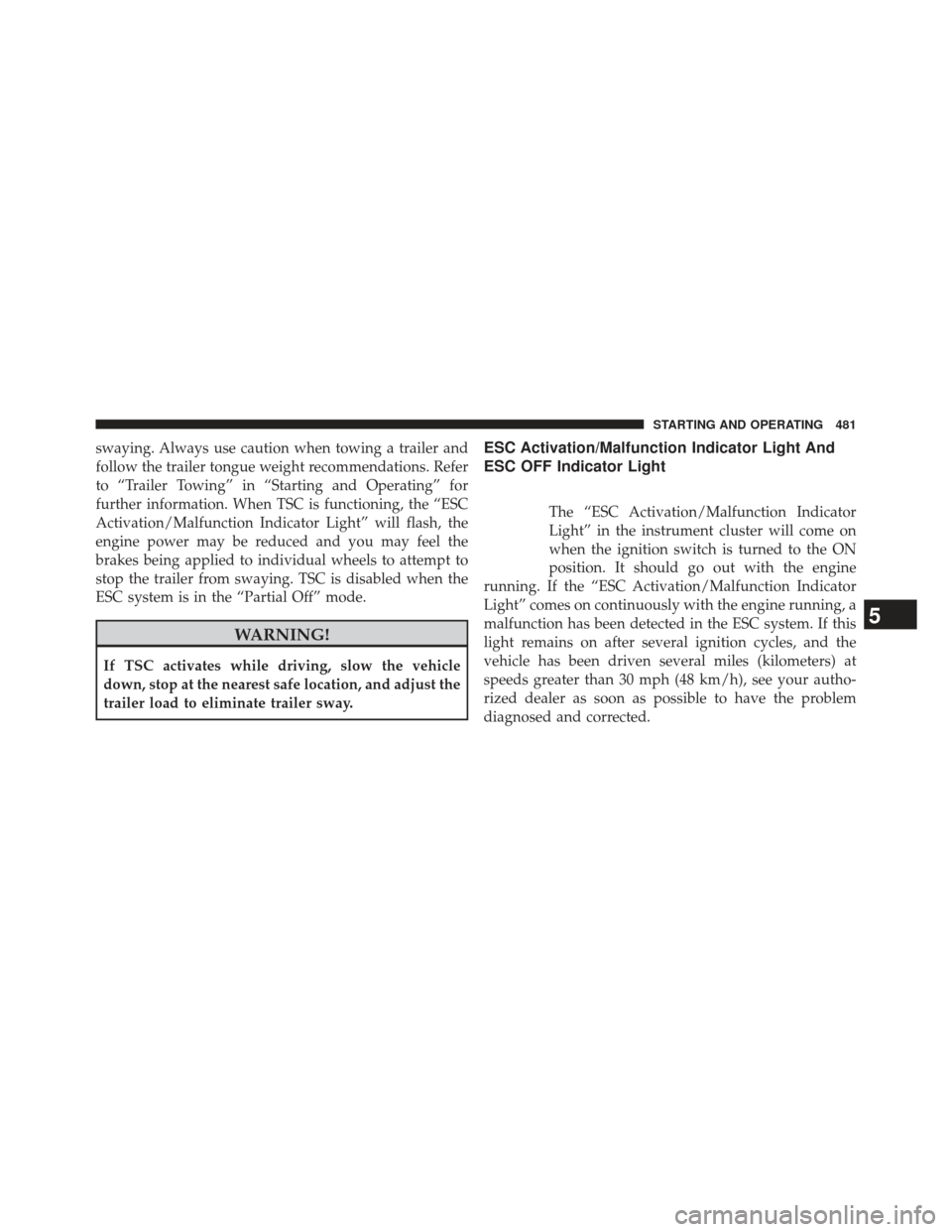
swaying. Always use caution when towing a trailer and
follow the trailer tongue weight recommendations. Refer
to “Trailer Towing” in “Starting and Operating” for
further information. When TSC is functioning, the “ESC
Activation/Malfunction Indicator Light” will flash, the
engine power may be reduced and you may feel the
brakes being applied to individual wheels to attempt to
stop the trailer from swaying. TSC is disabled when the
ESC system is in the “Partial Off” mode.
WARNING!
If TSC activates while driving, slow the vehicle
down, stop at the nearest safe location, and adjust the
trailer load to eliminate trailer sway.
ESC Activation/Malfunction Indicator Light And
ESC OFF Indicator Light
The “ESC Activation/Malfunction Indicator
Light” in the instrument cluster will come on
when the ignition switch is turned to the ON
position. It should go out with the engine
running. If the “ESC Activation/Malfunction Indicator
Light” comes on continuously with the engine running, a
malfunction has been detected in the ESC system. If this
light remains on after several ignition cycles, and the
vehicle has been driven several miles (kilometers) at
speeds greater than 30 mph (48 km/h), see your autho-
rized dealer as soon as possible to have the problem
diagnosed and corrected.
5
STARTING AND OPERATING 481
Page 528 of 661

WARNING!(Continued)
•Weight Distributing Systems may not be compatible
with Surge Brake Couplers. Consult with your hitch
and trailer manufacturer or a reputable Recreational
Vehicle dealer for additional information.
Trailer Hitch Classification
The following chart provides the industry standard for
the maximum trailer weight a given trailer hitch class can
tow and should be used to assist you in selecting the
correct trailer hitch for your intended towing condition.
Trailer Hitch Classification Definitions
Class Max. Trailer Hitch
Industry Standards
Class I - Light Duty 2,000 lbs (907 kg)
Class II - Medium Duty 3,500 lbs (1 587 kg)
Class III - Heavy Duty 5,000 lbs (2 268 kg)
Class IV - Extra Heavy
Duty 10,000 lbs (4 540 kg)
Refer to the “Trailer Towing Weights (Maximum
Trailer Weight Ratings)” chart for the Maximum
Gross Trailer Weight (GTW) towable for your given
drivetrain.
All trailer hitches should be professionally installed
on your vehicle.
526 STARTING AND OPERATING
Page 586 of 661
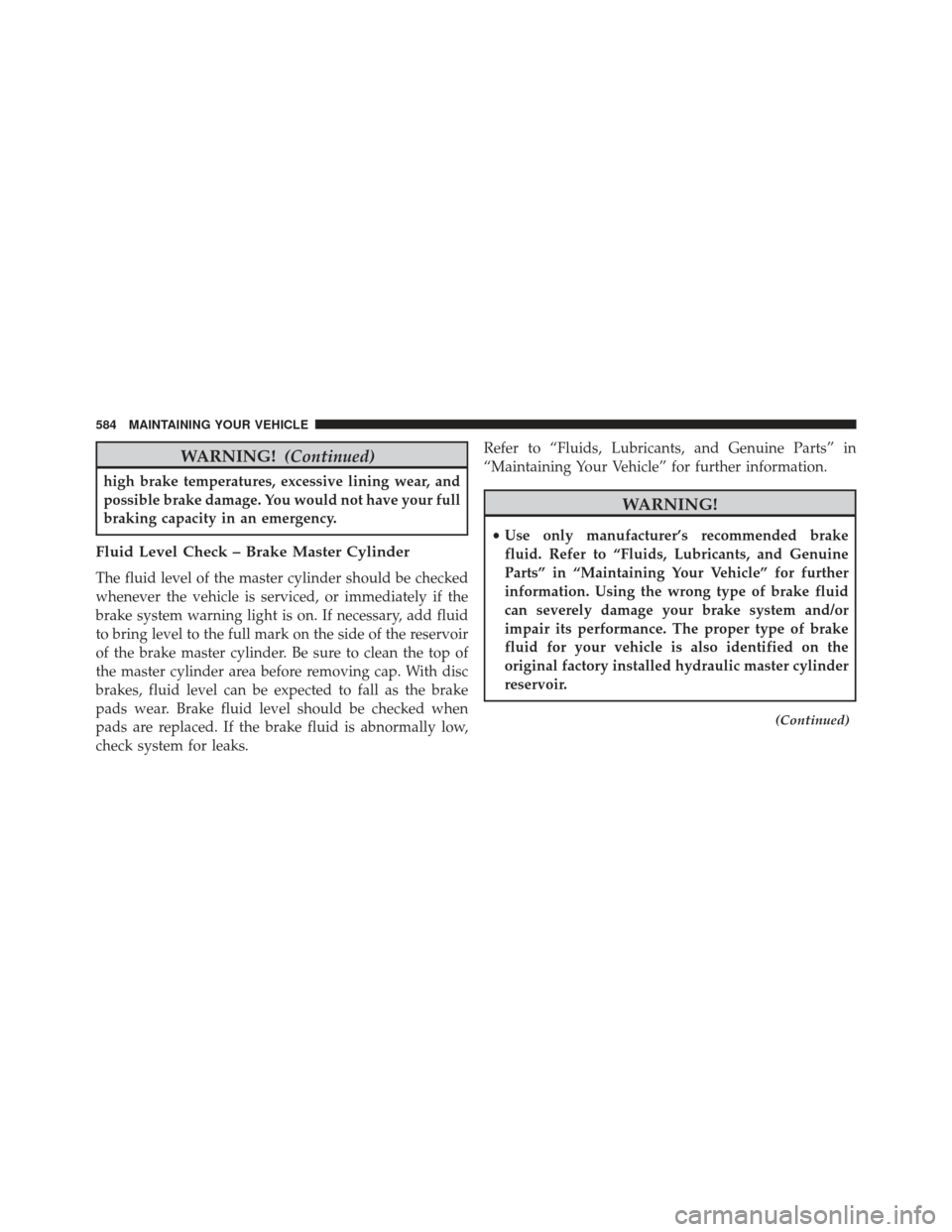
WARNING!(Continued)
high brake temperatures, excessive lining wear, and
possible brake damage. You would not have your full
braking capacity in an emergency.
Fluid Level Check – Brake Master Cylinder
The fluid level of the master cylinder should be checked
whenever the vehicle is serviced, or immediately if the
brake system warning light is on. If necessary, add fluid
to bring level to the full mark on the side of the reservoir
of the brake master cylinder. Be sure to clean the top of
the master cylinder area before removing cap. With disc
brakes, fluid level can be expected to fall as the brake
pads wear. Brake fluid level should be checked when
pads are replaced. If the brake fluid is abnormally low,
check system for leaks. Refer to “Fluids, Lubricants, and Genuine Parts” in
“Maintaining Your Vehicle” for further information.
WARNING!
•
Use only manufacturer’s recommended brake
fluid. Refer to “Fluids, Lubricants, and Genuine
Parts” in “Maintaining Your Vehicle” for further
information. Using the wrong type of brake fluid
can severely damage your brake system and/or
impair its performance. The proper type of brake
fluid for your vehicle is also identified on the
original factory installed hydraulic master cylinder
reservoir.
(Continued)
584 MAINTAINING YOUR VEHICLE
Page 615 of 661
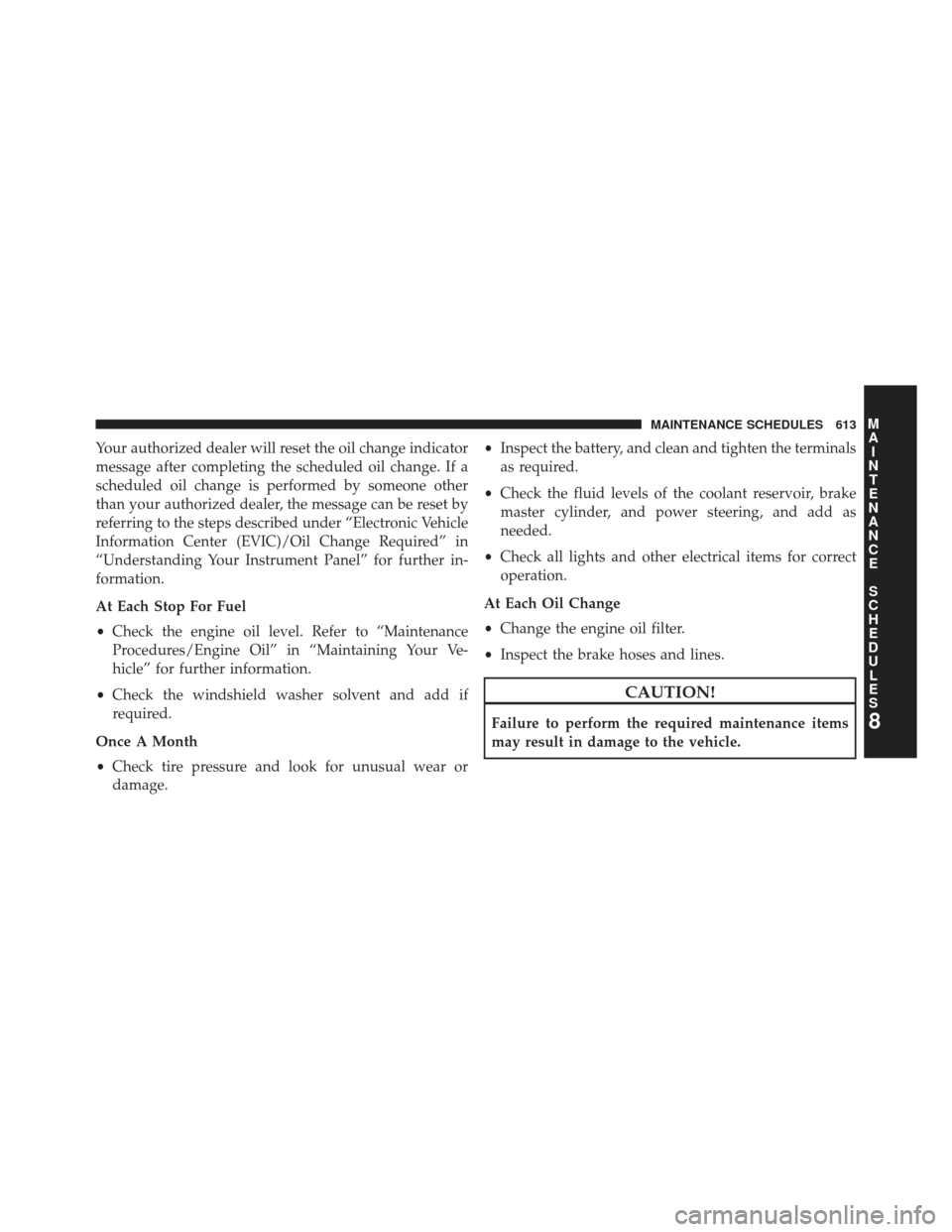
Your authorized dealer will reset the oil change indicator
message after completing the scheduled oil change. If a
scheduled oil change is performed by someone other
than your authorized dealer, the message can be reset by
referring to the steps described under “Electronic Vehicle
Information Center (EVIC)/Oil Change Required” in
“Understanding Your Instrument Panel” for further in-
formation.
At Each Stop For Fuel
•Check the engine oil level. Refer to “Maintenance
Procedures/Engine Oil” in “Maintaining Your Ve-
hicle” for further information.
• Check the windshield washer solvent and add if
required.
Once A Month
• Check tire pressure and look for unusual wear or
damage. •
Inspect the battery, and clean and tighten the terminals
as required.
• Check the fluid levels of the coolant reservoir, brake
master cylinder, and power steering, and add as
needed.
• Check all lights and other electrical items for correct
operation.
At Each Oil Change
• Change the engine oil filter.
• Inspect the brake hoses and lines.
CAUTION!
Failure to perform the required maintenance items
may result in damage to the vehicle.8
M
A I
N T
E
N
A
N
C E
S
C
H E
D
U L
E
SMAINTENANCE SCHEDULES 613
Page 642 of 661
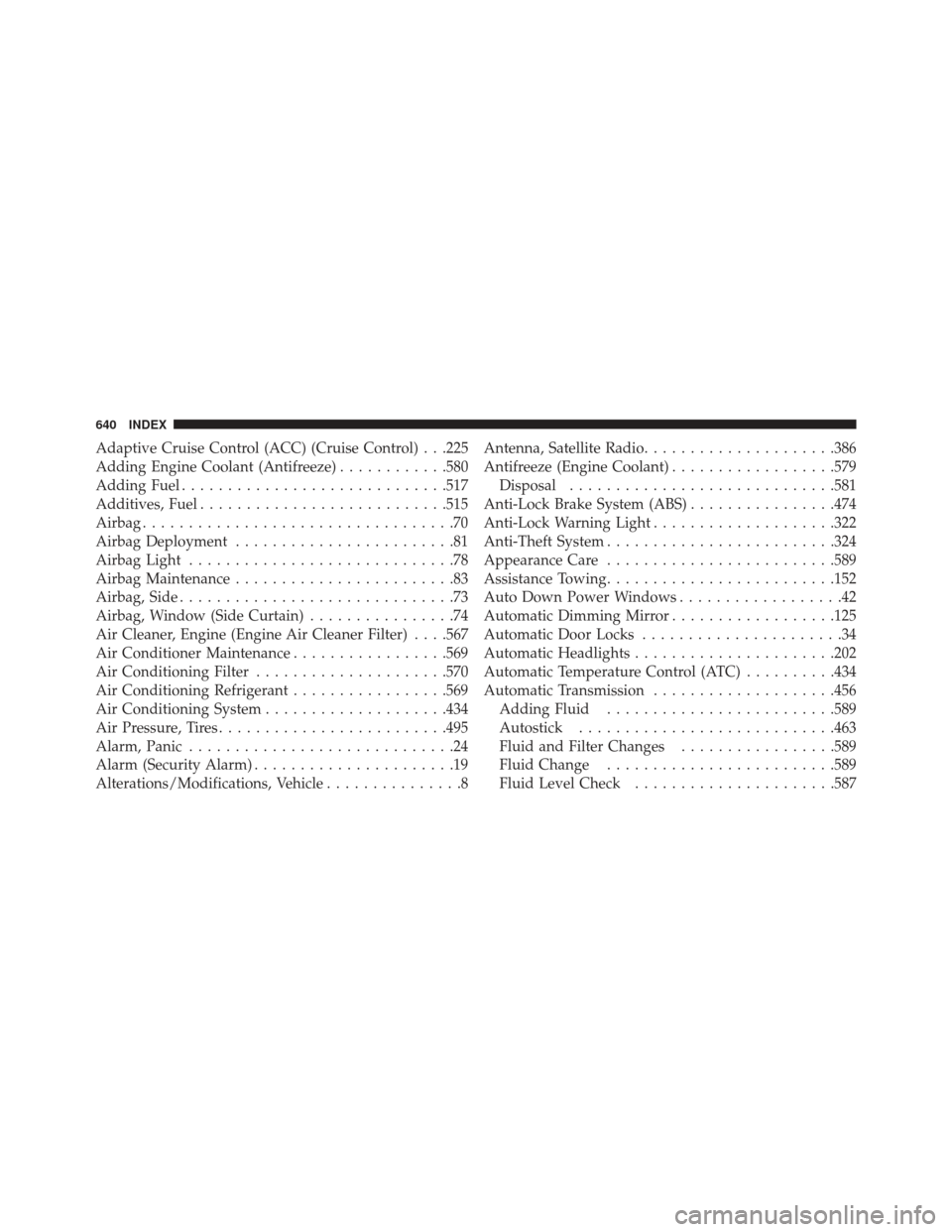
Adaptive Cruise Control (ACC) (Cruise Control) . . .225
Adding Engine Coolant (Antifreeze)............580
Adding Fuel ............................ .517
Additives, Fuel .......................... .515
Airbag ..................................70
Airbag Deployment ........................81
Airbag Light .............................78
Airbag Maintenance ........................83
Airbag, Side ..............................73
Airbag, Window (Side Curtain) ................74
Air Cleaner, Engine (Engine Air Cleaner Filter) . . . .567
Air Conditioner Maintenance .................569
Air Conditioning Filter .....................570
Air Conditioning Refrigerant .................569
Air Conditioning System ....................434
Air Pressure, Tires ........................ .495
Alarm, Panic .............................24
Alarm (Security Alarm) ......................19
Alterations/Modifications, Vehicle ...............8Antenna, Satellite Radio
.....................386
Antifreeze (Engine Coolant) ..................579
Disposal ............................ .581
Anti-Lock Brake System (ABS) ................474
Anti-Lock Warning Light ....................322
Anti-Theft System ........................ .324
Appearance Care ........................ .589
Assistance Towing ........................ .152
Auto Down Power Windows ..................42
Automatic Dimming Mirror ..................125
Automatic Door Locks ......................34
Automatic Headlights ..................... .202
Automatic Temperature Control (ATC) ..........434
Automatic Transmission ....................456
Adding Fluid ........................ .589
Autostick ........................... .463
Fluid and Filter Changes .................589
Fluid Change ........................ .589
Fluid Level Check ..................... .587
640 INDEX
Page 643 of 661

Fluid Type.......................... .587
Special Additives ...................... .588
Autostick .............................. .463
Auxiliary Electrical Outlet (Power Outlet) ........286
Auxiliary Power Outlet .....................286
Battery ................................ .568
Keyless Transmitter Replacement (RKE) ........25
Belts, Seat ...............................54
Blind Spot Monitoring ..................... .129
Body Mechanism Lubrication .................572
B-Pillar Location ......................... .489
Brake Assist System ...................... .475
Brake Control System, Electronic ..............473
Brake Fluid ............................ .584
Brake System ........................... .583
Anti-Lock (ABS) ...................... .474
Fluid Check .......................... .584
Master Cylinder ....................... .584Parking
............................. .471
Warning Light ........................ .321
Brake/Transmission Interlock .................455
Break-In Recommendations, New Vehicle ........111
Bulb Replacement ........................ .602
Bulbs, Light .............................116
Calibration, Compass ..................... .353
Camera, Rear ........................... .264
Capacities, Fluid ......................... .608
Caps, Filler Fuel ............................... .517
Oil (Engine) ......................... .566
Radiator (Coolant Pressure) ...............581
Carbon Monoxide Warning ..................113
Cargo Area Cover ........................ .300
Cargo Area Features ...................... .297
Cargo Compartment ...................... .297
Light .............................. .298
10
INDEX 641
Page 645 of 661

Points to Remember.....................582
Pressure Cap ......................... .581
Radiator Cap ......................... .581
Selection of Coolant (Antifreeze) ............579
Corrosion Protection ...................... .589
Cruise Control (Speed Control) ................225
Cupholders ............................ .293
Customer Assistance ...................... .631
Data Recorder, Event .......................84
Daytime Running Lights ....................204
Dealer Service ........................... .562
Defroster, Rear Window .....................304
Defroster, Windshield ......................114
Disabled Vehicle Towing ....................555
Disposal Antifreeze (Engine Coolant) ...............581
Door Locks ..............................32
Door Locks, Automatic ......................34 Door Opener, Garage
...................... .269
Driving Through Flowing, Rising, or Shallow
Standing Water ....................... .467
Driving to Achieve Maximum Fuel Economy ......342
Electrical Outlet, Auxiliary (Power Outlet) ........286
Electric Rear Window Defrost .................304
Electric Remote Mirrors .....................127
Electronic Brake Control System ...............473
Brake Assist System .....................475
Electronic Roll Mitigation (ERM) ..............475
Electronic Speed Control (Cruise Control) ........221
Electronic Stability Control (ESC) ..............476
Electronic Vehicle Information Center (EVIC) ......318
Emergency, In Case of Freeing Vehicle When Stuck ...............552
Hazard Warning Flasher ..................536
Jump Starting ........................ .548
10
INDEX 643